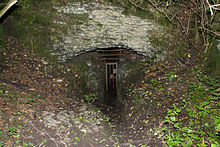Hollow stone cave
The hollow stone cave is located in the Teutoburg Forest near Kohlstädt in the North Rhine-Westphalian district of Lippe and is a nature conservation and FFH area .
It was explored as early as 1779 as one of the most important caves in East Westphalia in the fissure system of marl limestone of the Upper Cretaceous (Turon, Lamarki layers). However, with a few exceptions, it is denied access to the public today, as it has been designated a natural monument and is a wintering area for bats .
Geographical location
The hollow stone cave is located in the southeast part of the Teutoburg Forest about 3 km southwest of the interface with the south-facing Egge Mountains . It is located around two kilometers east-northeast of Kohlstädt , a north-eastern district of the community in Schlangen in the south of Lippe . Its entrance is about 250 meters (as the crow flies ) west of the Hohlestein summit ( 433.2 m above sea level ) at around 420 m above sea level. NN .
Brief description
The natural cleft cave , like the Lukenloch and the Bielstein cave on Bauernkamp, was formed in the Plänerkalk. It has a total length of approx. 200 m. The greatest height is 47 meters. The entrance area is provided with a four meter high and 0.5 to 1.5 m wide grille and has a sloping, rubble-covered floor. A bottleneck after 30 m extends the cave into two chambers, which contain stalactite formations in the rear and hard-to-reach parts .
fauna
The well-preserved cave is particularly significant in terms of its valuable fauna . It is used by bats most of the year. So far the bat species bearded bat , brown long-eared bat , fringed bat , water bat , large mouse- eared bat and pond bat have been detected. With 35 animals the largest number of the great mouse-eared mouse has been counted in winter quarters. The entrance is barred to protect the cave and the bats from disturbance.
A special feature is the existence of the bat cave beetle ( Choleva septentrionis sokolowskii n. Ssp.), Which occurs as a special subspecies worldwide only in this one cave. As a larva and adult, it feeds on deceased bats, bat droppings and leftover food.
See also
- List of caves
- List of nature reserves in the Lippe district
- List of FFH areas in North Rhine-Westphalia
literature
- Georg Heese, The Secret of the Hollow Stone Cave , 4-part series, 1926, Lippische Landeszeitung
- Hubert Trimmel, Speleology , Vieweg, Braunschweig 1968
- Hans Morlo, The caves in Lippe and in the Paderborner Land , Karst and Höhle, 1982/83, pp. 121–170
Web links
- Nature reserve "LIP-061 Hohlsteinhöhle" in the specialist information system of the State Office for Nature, Environment and Consumer Protection in North Rhine-Westphalia
- Natura 2000 area "DE-4119-305 Hohlsteinhöhle" in the specialist information system of the State Office for Nature, Environment and Consumer Protection in North Rhine-Westphalia
- Photo documentation
Individual evidence
- ↑ Topographical Information Management, Cologne District Government, Department GEObasis NRW ( Notes )
- ↑ Arnt Becker, Matthias Füller, Astrid Fölling, Rene Reifenbach: Activities of bats in the hollow stone cave (Lippe district). Reports natural science. Association for Bielefeld and the surrounding area 53 (2015) 248-267
- ↑ Planned Teutoburg Forest and Eggegebirge National Park ( Memento of the original from March 5, 2016 in the Internet Archive ) Info: The archive link has been inserted automatically and has not yet been checked. Please check the original and archive link according to the instructions and then remove this notice.
Coordinates: 51 ° 49 ′ 59.1 ″ N , 8 ° 54 ′ 30.2 ″ E


